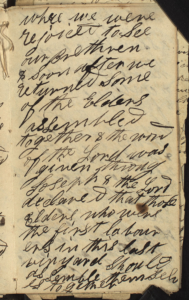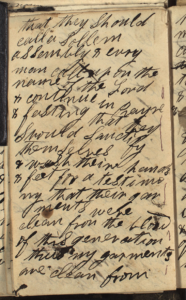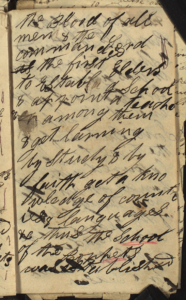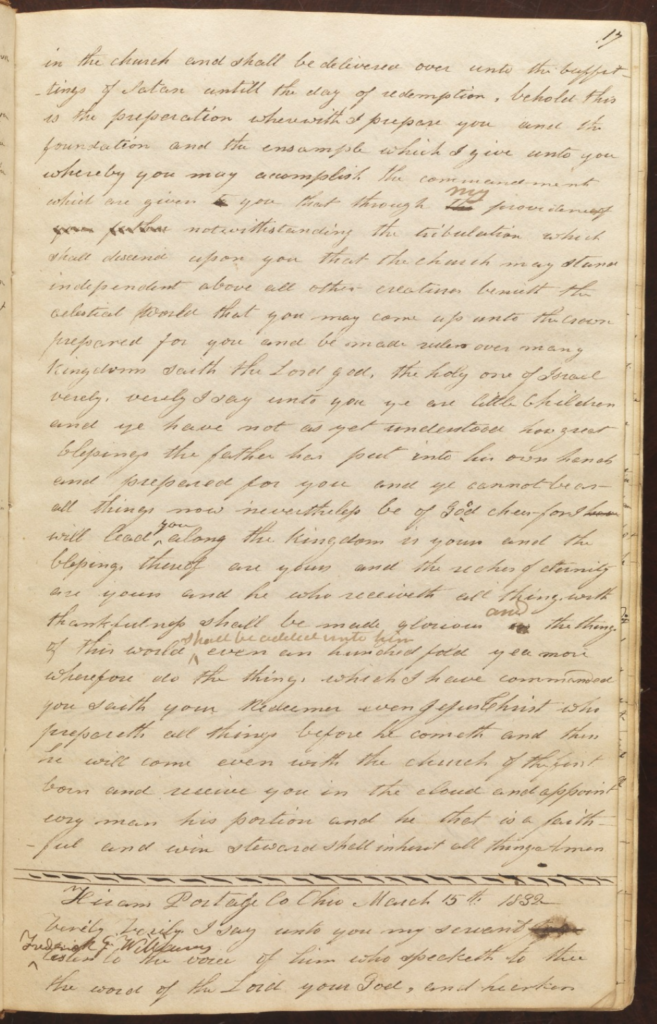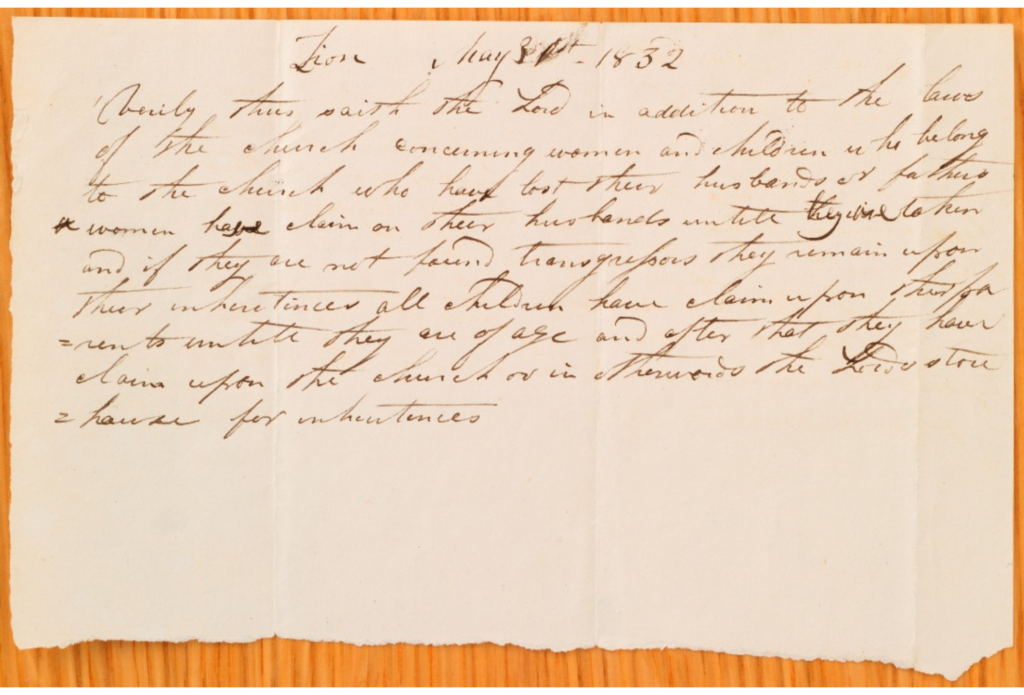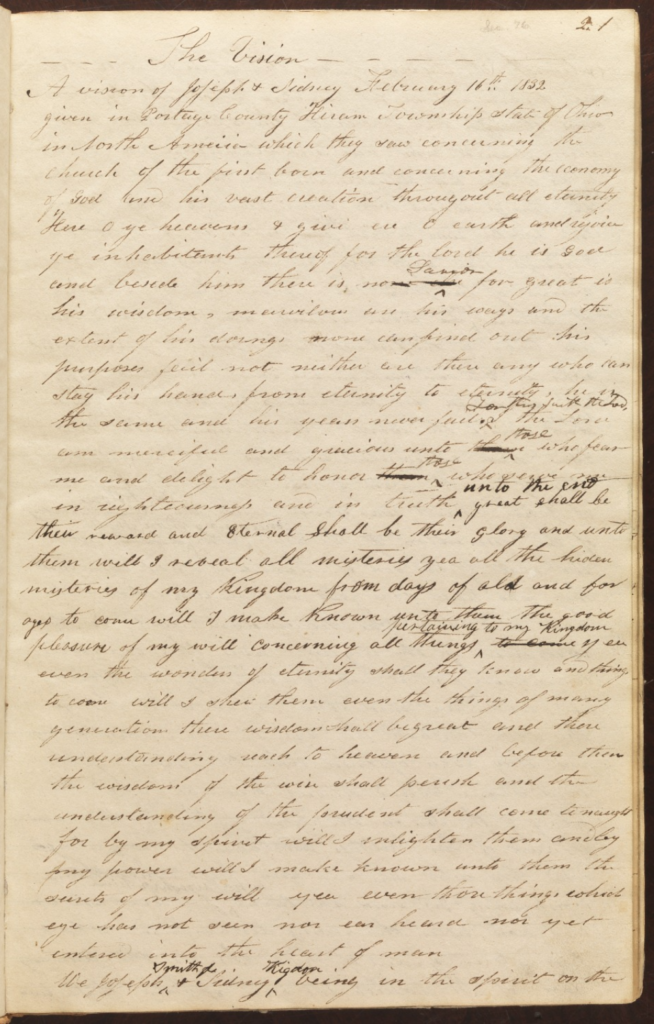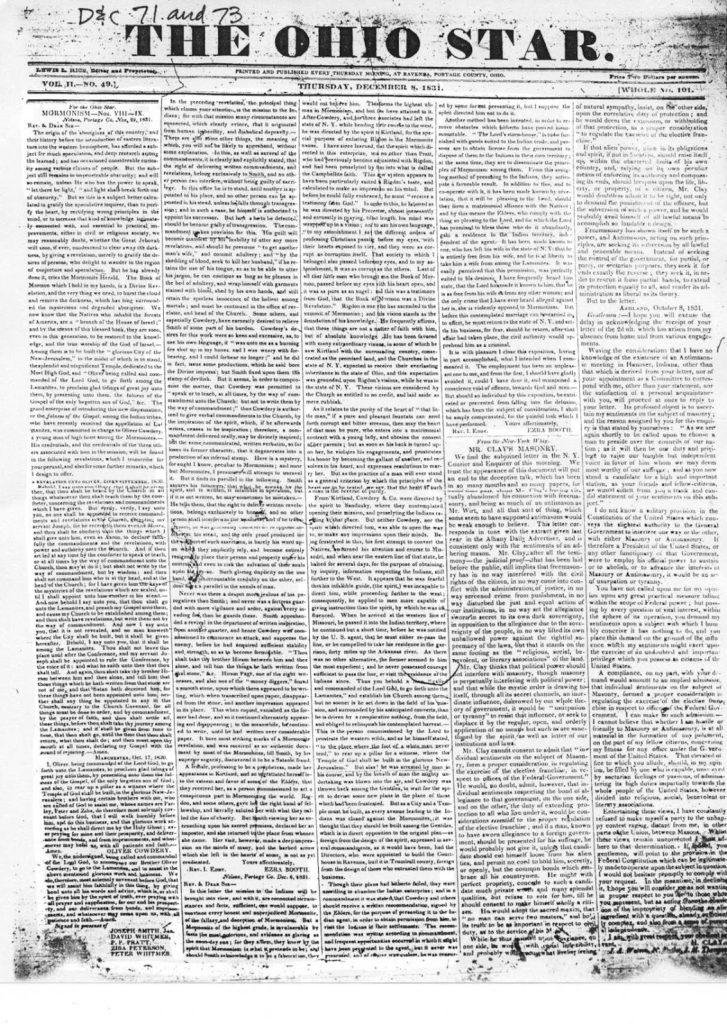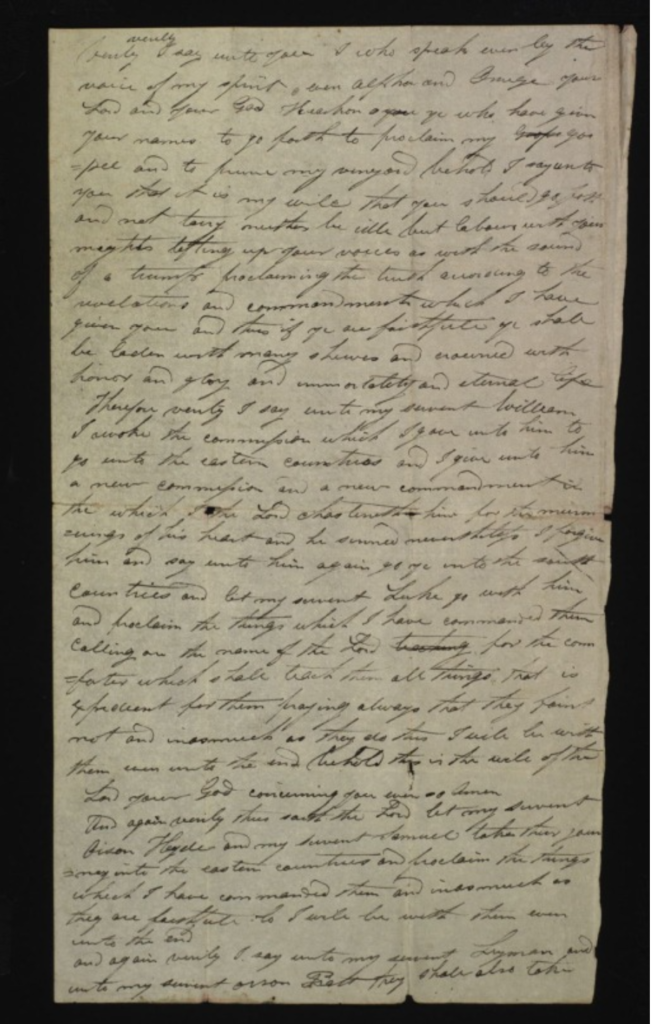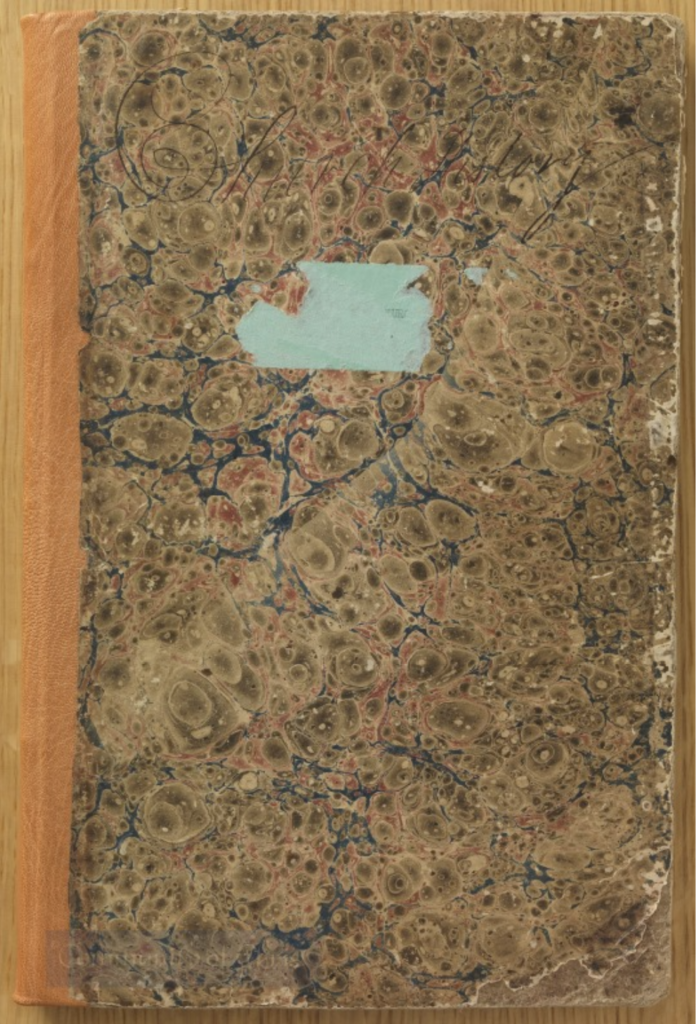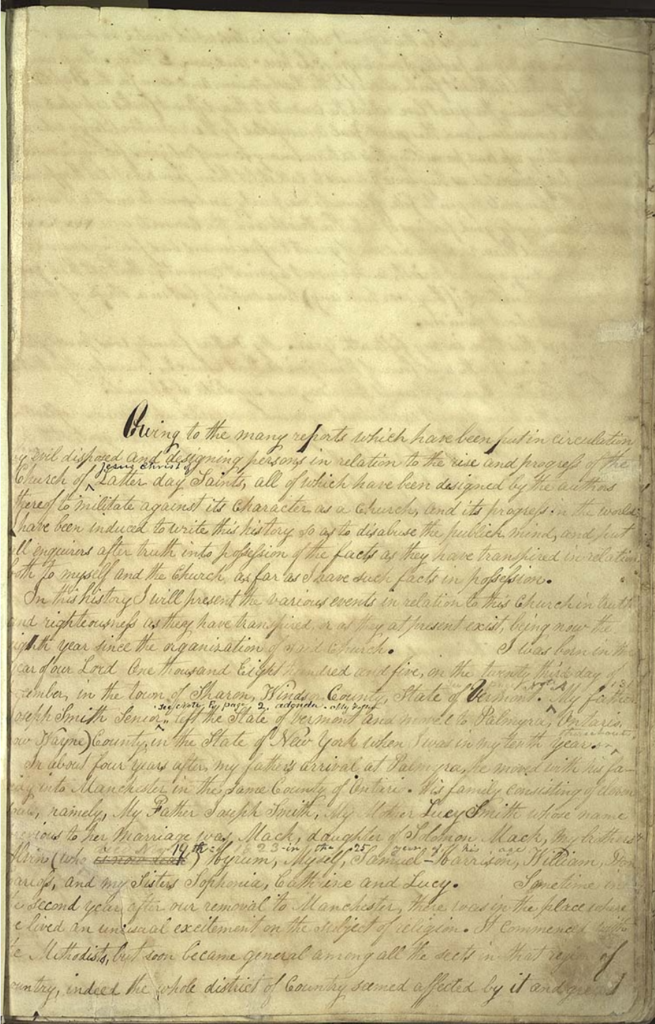Section 89
Most everyone drank in the 1820s and 1830s, Joseph Smith included.[1] Distillers in his upstate New York neighborhood made corn whiskey and sent 65,277 gallons of it and 69 tons of beer to market on the Erie Canal the year after Joseph’s first vision of God and Christ.[2] Newspapers in the towns near Joseph’s home advertised cheap alcohol, printed recipes for making beer, and sold the ingredients. One scholar aptly described Joseph’s America as “the alcoholic republic.”[3]
Joseph’s father confessed in a patriarchal blessing to his son Hyrum in 1834 that he had been “out of the way through wine” sometimes in the past, but “Joseph Sr.’s drinking was not excessive for that time and place.”[4] Nearly all males drank and many women and children. Members of all social classes drank. They drank morning, mid-day, and evening, at funerals and parties, militia musters and church socials.
“The thing has arrived to such a height,” one widely-quoted temperance advocate noted, “that we are actually threatened with becoming a nation of drunkards.”[5] America’s desire for alcohol and the rise of temperance generated diverse opinions that led Joseph Smith to ask questions. Between 1831 and 1836, the cry for abstinence gained momentum. In 1833, in the middle of this controversy, the Lord clarified revealed where the Saints should stand relative to alcohol consumption.
Americans consumed enormous amounts of meat. Authorities often condoned this practice in winter but worried that too much consumption could result in over-stimulation. All authorities agreed that use of all stimulants, in which they included herbs, meats, coffee, and tea, could lead to over-stimulation and therefore disease. The most radical authorities, especially Sylvester Graham, thought that foods much more tasty than a Graham cracker (named for Sylvester) were very dangerous. He urged complete abstinence from coffee, tea, meat, spices, and condiments. Granting that coffee and tea were stimulants, other authorities thought Graham’s position too extreme and believed that healthy people could consume these drinks in moderation without causing disease.
By 1800, the influential doctor Benjamin Rush had persuaded many authorities that all disease could be traced to over-stimulation, and therefore all illness could be treated by so-called “heroic” methods of releasing the patient’s excess energy. Joseph Smith’s brother Alvin died in 1823 after a doctor’s dose of mercurous chloride blocked rather than purged his digestive system. Joseph Smith and most Latter-day Saints had little confidence in the fledgling medical profession and its heroic practices. In the days of primitive diagnostic techniques before diseases were well understood, an 1831 revelation to Joseph Smith taught Saints that “whosoever among you are sick, and have not faith to be healed, but believe, shall be nourished with all tenderness, with herbs and mild food, and that not by the hand of an enemy” (D&C 42:43). This counsel matched most closely the relatively innocuous naturopathic practices of Samuel Thomson, and many Latter-day Saints followed his advice until advances in medical science increased their confidence in professionals late in the nineteenth century.[6]
The world into which the Lord revealed the Word of Wisdom was quite different from our own. Advances in medical science have provided much more certainty about the dangers of consuming many of the substances that were thought by many in Joseph Smith’s world to have medicinal value. Moreover, his contemporaries were in the process of reconsidering their certainty about the value of alcohol, tobacco, coffee, tea, meats, fruits, and some herbs. There was no prevailing view to which everyone subscribed, even inside the Church. There were more questions than answers.
Outspoken temperance crusaders added tobacco to their list of noxious substances in the 1830s, and it became as warmly debated as alcohol. Was tobacco a powerful medicine capable of curing all kinds of afflictions or a noxious weed that was loathsome to the lungs? Was it filthy habit or a socially acceptable pastime? Uncertainty about these questions may have been the immediate catalyst for Joseph Smith’s reception of the Word of Wisdom.
Nearly two dozen men gathered for school in a second-story room of Newel and Ann Whitney’s Kirtland, Ohio, store on February 27, 1833. “The first thing they did,” according to Brigham Young, “was to light their pipes, and, while smoking, talk about the great things of the kingdom, and spit all over the room, and as soon as the pipe was out of their mouths a large chew of tobacco would then be taken. Often when the Prophet entered the room to give the school instructions he would find himself in a cloud of tobacco smoke. This, and the complaints of his wife at having to clean so filthy a floor, made the Prophet think upon the matter, and he inquired of the Lord.”[7]
With one of the elders for his scribe and perhaps one or two others present, Joseph Smith, in a nearby room, received the revelation known as the Word of Wisdom. Besides answering the immediate question of whether the brethren should smoke or chew tobacco, or “the filthy weed and their disgusting slobbering and spitting” as one colorful account put it, the revelation clarified several other issues that were being debated by Joseph’s contemporaries.[8]
One of the most unusual aspects of the word of wisdom is that although it came in answer to pressing questions in 1833, its primary purpose is to forewarn future saints of conspiracies to undermine their agency. Notice the doctrinal basis of the revelation. It assumes, as an earlier revelation to Joseph Smith said, that “the spirit and the body are the soul of man” (D&C 88:15). Whereas some Christians think of the body as evil and look forward to leaving it behind at death, Latter-day Saints regard the body as godly and look forward to a literal, glorious resurrection. They believe God and Christ are perfectly embodied and that through the process of birth, earth-life, death, and resurrection, men and women are being created in their image. To preserve the soul and its agency to act for itself, the Lord forbade drinking strong drinks and also wine, unless it was for the sacrament.[9]
The revelation instructs people how to act relative to distilled (“strong”) and fermented drinks, domesticated and wild animals, tobacco, hot drinks, grains, herbs, fruits, and vegetables. These are all things God has made and given mankind to use. The revelation tells us how to use them in ways that please God. “All these to be used with prudence and thanksgiving,” for example, speaking of herbs and fruits (D&C 89:11), or “they are to be used sparingly,” speaking of meat and poultry (D&C 89:12). A seldom noted aspect of stewardship in the Word of Wisdom is the repeated command to use what God has provided “with thanksgiving” (D&C 89:11–12). The repeated emphasis is on righteous use, not abuse. God created this earth and its life-sustaining abundance to be used by wise stewards who thankfully acknowledge him, not abused by the ungrateful or gluttonous.
The Word of Wisdom more than a simple health code. It is a covenant. Elder Boyd K. Packer testified that “while the Word of Wisdom requires strict obedience, in return it promises health, great treasures of knowledge, and that redemption bought for us by the Lamb of God, who was slain that we might be redeemed.”[10]
Some critics of the Word of Wisdom assert that because it addressed the circumstances of Joseph Smith’s world, it must not be real revelation. That is silly, since it assumes that a revelation that answers timely questions is somehow suspect. What good is an irrelevant revelation? Another simplistic assumption is that the Word of Wisdom mimicked the prevailing idea of Joseph’s time. There was no prevailing idea, no single opinion. Then as now there were many competing ideas, debate rather than consensus.
The Word of Wisdom sorts out and clarifies the strengths and weaknesses among the variety of opinions. Forbidding the ingestion of nearly all alcoholic beverages as well as coffee, tea, and tobacco, the revelation ran counter to the mainstream culture. It was consistent, however, with an emerging medical opinion regarding meats, herbs, fruits, and vegetables. The revelation did not give Joseph Smith, his followers, or family members what they wanted to hear. Many of the men in the church used tobacco. Emma Smith took coffee and tea. Joseph liked whiskey.[11] They all consumed more meat than was needful.[12] The revelation was not what they wanted to hear. It was the wisdom they needed to hear.
Section 90
There is nothing in the historical records to tell us what problem(s) section 90 resolved—nothing but the revelation itself.[1] In such cases it is extra important to read it carefully. It is full of financial instructions. It is safe to conclude that Joseph was concerned about the expensive commands the Lord had given to buy land in Missouri, establish a storehouse, print the revelations, and gather Israel to Zion.
The revelation was given, at least in part, to answer Joseph’s prayers for forgiveness, mentioned in verse 1, which also says that prayers of Joseph’s brethren that have reached the Lord’s ears. It seems that those brethren were Sidney Rigdon, who had been serving as Joseph’s counselor, and Frederick Williams, who just a few weeks earlier received a revelation through Joseph that he was “called to be a Councillor & scribe unto my Servent Joseph.”[2] The Lord refers “again” to these “brethren” by name in verse 6.
Section 90 blesses those who bear the keys of the kingdom, the authority to exercise the priesthood to govern the church of Jesus Christ. It grants them the oracles—the revelations to govern the church—and commands the saints not to take them lightly.
The revelation takes the next step in forming what section 81 called the “presidency of the high priesthood,” or what became known by 1835 as the First Presidency.[3]
The Lord forgives Sidney Rigdon and Frederick Williams and makes them equal with Joseph in holding the keys of the kingdom. Verse 9 nevertheless clarifies that Joseph presides over his counselors, who preside over the earth and are commanded by the Lord to spread the gospel and gather Israel in anticipation of His coming.
Beginning in verse 13, the Lord gives the Presidency their day to day duties: To finish revising the Old Testament, to preside over the church and the school of the prophets (see section 88), to receive revelations as needed, to study and learn all they can, and to preside over and set the church in order.
Verses 13 through the end include the kind of revelation needed to set the church in order. Here the Lord micromanages his affairs with specific instructions about a variety of people, property, and finances. Joseph and his counselors are reproved and instructed for their pride and directed to be better. The church is to provide a home for Frederick Williams, who had consecrated his farm to obey the same revelation that called him to be a counselor to Joseph. Joseph’s parents are to live on Frederick’s farm, Sidney to remain where he lived, and the bishop to find an agent both faithful and wealthy enough to help pay the church’s debts.
The Lord refers to the United Firm’s covenant (section 82) in verse 24, which is itself a covenant. In verse 25 he counsels Joseph’s father to conserve his financial resources by not assuming responsibility for more people than he can afford in his advancing years. Vienna Jacques, a converted Bostonian who had gathered with the saints and consecrated her considerable wealth, is promised an inheritance in Zion for her faithfulness.
No so with William McLellin, whom the Lord rebukes after he forsook two mission calls and circumvented the law of consecration to purchase two lots on Main Street in Independence, Missouri (see sections 66, 75, and 85).[4] The Lord also reproved church leaders in Zion who were badgering Joseph to come to Missouri to live.
Ten days after the revelation, a council of high priests convened. Joseph ordained Sidney Rigdon and Frederick Williams “by the laying on of hands to be equal with him in holding the Keys of the Kingdom and also to the Presidency of the high Priesthood.”[5]
The pressures of Zion building Zion weighed on Joseph. One can hear sub-textually that Joseph did not know how to resolve some pressing problems, but the Lord did. He coached Joseph how to cope, strategize, delegate, prepare, and press forward. The revelation reassured Joseph that the keys were his forever and he would receive revelations as needed. Section 90 treated Joseph’s anxiety, uncertainty, and stress. Zion, “shall not be removed out of her place. I, the Lord, have spoken it” (D&C 90:37). If the Lord was so cool and confident in Zion, Joseph could be too. He would need that reassurance. Things in Zion were about to get much worse.
Section 91
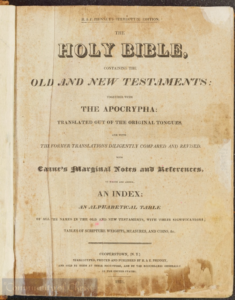
There was a hot debate among member of the British and Foreign Bible Society in the late 1820s. Some members advocated that the Society should include in its Bibles the Apocrypha—“the dozen or so books not found in the Hebrew canon but that were included in the Greek version of the Old Testament.”[1] Other members of the Society thought they were “adulterating the Scriptures, by circulating the lies and fables of the Apocrypha along with the words of eternal life.”[2] That debate had been ongoing among Christians for centuries. Joseph did not know whose argument was best.
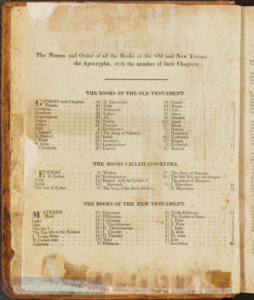
Joseph’s version of the King James Bible included the Apocrypha. Section 90, revealed on March 8, 1833, told Joseph to finish his revision of the Old Testament before moving on to other pressing duties. The next day he asked the Lord whetherhe should read the Apocrypha and revise it along with the rest of the Old Testament. His history says, “having come to that portion of the ancient writings called the Apocrypha, I received the following” revelation.[3]
The Lord tells Joseph the he need not translate the Apocrypha, and he explains why. Much of it is true and already translated correctly. Much of it is not true, late additions, uninspired, and uninspiring. The revelation hinges on the therefore that begins verse 4. Because there is much truth and much else in the Apocrypha, let it be understood by the Spirit, which testifies of truth. That is the way to get the most from the Apocrypha.
Section 91 helps us understand the nature of scripture and of revelation. There have been many historical arguments and dogmatic positions taken relative to the Apocrypha. The revealed answer may be the least dogmatic. Rather than declaring the highly varied books of the Apocrypha absolutely true or false, the Lord focuses on truth and error within the texts. Nor does he seem worried about errors in or sufficiency of scripture, a term Latter-day Saints do not even use. He gives instead an infallible principle that can be applied to all texts and all subjects. The principle is that seeking truth in the light of the Holy Spirit will enable people to discern truth from error wherever they may be found.
Section 92
People live by the law of consecration and stewardship. When people say that early saints lived the United Order, they do not understand what it is—or was. United Order is actually a pseudonym for the United Firm, a group of several church leaders the Lord named specifically in section 82. “As a governing financial council, the firm was responsible for printing church publications, holding church properties in trust, assisting the poor, and operating general stores in Independence, Missouri, and Kirtland, Ohio, to generate funds for the church.”[1]
The Lord established the United Firm in 1832 (see section 82).[2] In 1833, the Lord called Frederick Williams to be a counselor and scribe to Joseph and to consecrate his substantial farm to the church. “Let thy farm be consecrated for bringing forth of the revelations and tho[u] shalt be blessed,” the Lord told Frederick.[3] Section 92 made Frederick a member of the United Firm.[4] The minutes describing what it means say that Frederick “should be received into the United Firm in full partnership agreeable to the specification of the bond” mentioned in Sections 78:11 and 82:11.[5] Section 92 instructs the members of the United Firm to receive Frederick and instructs him to be a “lively member.”
Joseph sent a copy of the revelation to the members of the firm in Missouri. They apparently raised some questions about Frederick’s role. He joined the firm, consecrated his farm, was ordained a counselor to Joseph Smith, continued to serve as a scribe, and was otherwise “lively” though soft spoken in building Zion. Joseph’s journal says, “Brother Frederick is one of those men in whom I place the greatest confidence and trust for I have found him ever full of love and Brotherly kindness. . . . He is perfectly honest and upright and seeks with all his heart to magnify his presidency in the church.”[6]
Section 89 notes
[1] Saints Herald, June 1, 1881, 163, 167.
[2] Western Farmer, January 30, 1822.
[3] W.J. Rorabaugh, The Alcoholic Republic: An American Tradition (New York: Oxford University Press, 1979).
[4] Richard Lyman Bushman, Joseph Smith: Rough Stone Rolling (New York: Knopf, 2005), 42.
[5] Quoted in Rorabaugh, Alcoholic Republic, 216.
[6] Cecil O. Samuelson Jr., “Medical Practices,” in Encyclopedia of Mormonism, ed. Daniel H. Ludlow, 4 vols. (New York: MacMillan, 1992), 2: 875.
[7] Brigham Young, in Journal of Discourses, 26 vols. (Liverpool: F.D. Richards, 1855–86), 12:158, February 8, 1868.
[8] Lyndon W. Cook, ed., David Whitmer Interviews (Orem, Utah: Grandin, 1991), 204.
[9] “Revelation, 27 February 1833 [D&C 89],” p. [113], The Joseph Smith Papers, accessed October 7, 2020, https://www.josephsmithpapers.org/paper-summary/revelation-27-february-1833-dc-89/1.
[10] Boyd K. Packer, “The Word of Wisdom: The Principle and the Promises,” Ensign, May 1996, 18.
[11] Joseph Smith address to the Mormons at Nauvoo on Last Sunday of April 1841, Reverend Julius A. Reed Collection, box 2, folder 15, Iowa State Historical Society, Iowa City, Iowa.
[12] Bush, “The Word of Wisdom in Early Nineteenth-Century Perspective,” 53, 63.
Section 90 notes
[1] “Revelation, 8 March 1833 [D&C 90],” p. [1], The Joseph Smith Papers, accessed October 9, 2020, https://www.josephsmithpapers.org/paper-summary/revelation-8-march-1833-dc-90/1.
[2] Revelation 5 January 1834 [1833], Frederick G. Williams Papers, Church History Library, Salt Lake City.
[3] “Revelation, 15 March 1832 [D&C 81],” p. 18, The Joseph Smith Papers, accessed October 9, 2020, https://www.josephsmithpapers.org/paper-summary/revelation-15-march-1832-dc-81/2.
[4] William McLellin to relatives, 4 August 1832, typescript, Community of Christ Archives, Independence, Missouri.
[5] “Minutes, 18 March 1833,” p. 16, The Joseph Smith Papers, accessed October 9, 2020, https://www.josephsmithpapers.org/paper-summary/minutes-18-march-1833/1. “License for Frederick G. Williams, 20 March 1833,” p. [1], The Joseph Smith Papers, accessed October 9, 2020, https://www.josephsmithpapers.org/paper-summary/license-for-frederick-g-williams-20-march-1833/1.
Section 91 notes
[1] Historical Introduction to “Revelation, 9 March 1833 [D&C 91],” p. 55, The Joseph Smith Papers, accessed September 9, 2020, https://www.josephsmithpapers.org/paper-summary/revelation-9-march-1833-dc-91/1#historical-intro.
[2] Quoted in https://www.josephsmithpapers.org/paper-summary/revelation-9-march-1833-dc-91/1#historical-intro.
[3] “History, 1838–1856, volume A-1 [23 December 1805–30 August 1834],” p. 279, The Joseph Smith Papers, accessed October 9, 2020, https://www.josephsmithpapers.org/paper-summary/history-1838-1856-volume-a-1-23-december-1805-30-august-1834/285.
Section 92 notes
[1] Historical Introduction to “Revelation, 15 March 1833 [D&C 92],” p. 55, The Joseph Smith Papers, accessed July 9, 2020, https://www.josephsmithpapers.org/paper-summary/revelation-15-march-1833-dc-92/1#historical-intro.
[2] Max H. Parkin, “Joseph Smith and the United Firm,” BYU Studies 46:3 (2007): 13.
[3] “Revelation, 5 January 1833,” p. [1], The Joseph Smith Papers, accessed July 9, 2020, https://www.josephsmithpapers.org/paper-summary/revelation-5-january-1833/1.
[4] “Revelation, 15 March 1833 [D&C 92],” p. 55, The Joseph Smith Papers, accessed July 9, 2020, https://www.josephsmithpapers.org/paper-summary/revelation-15-march-1833-dc-92/1.
[5] “Minute Book 1,” p. 11, The Joseph Smith Papers, accessed July 9, 2020, https://www.josephsmithpapers.org/paper-summary/minute-book-1/15.
[6] “History, 1838–1856, volume A-1 [23 December 1805–30 August 1834],” p. 380, The Joseph Smith Papers, accessed July 9, 2020, https://www.josephsmithpapers.org/paper-summary/history-1838-1856-volume-a-1-23-december-1805-30-august-1834/386.

